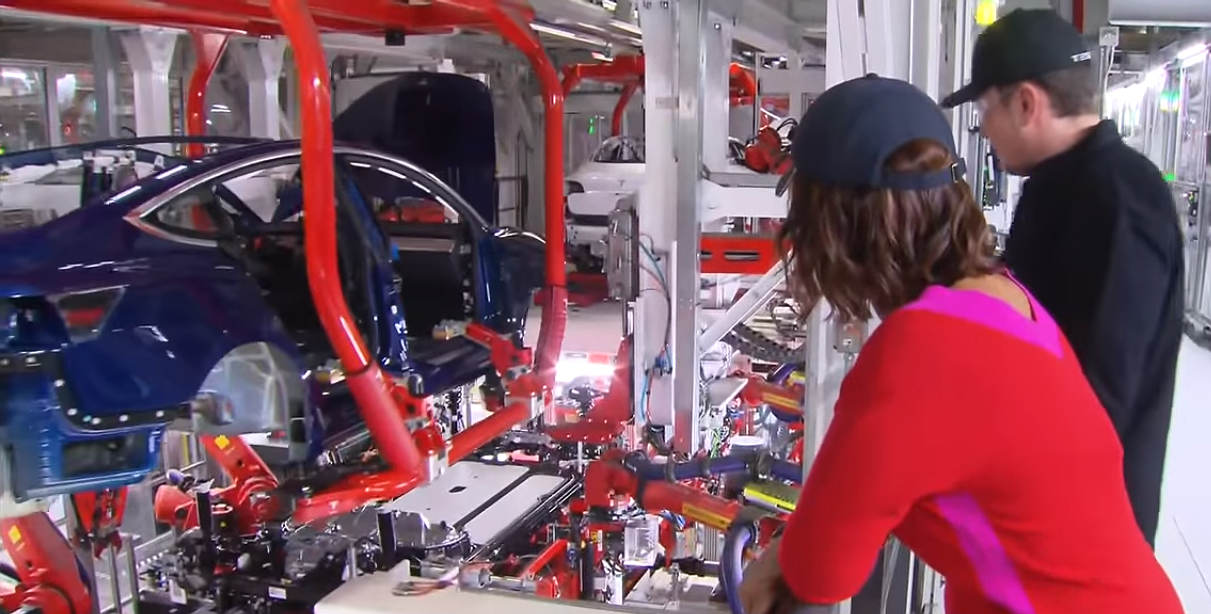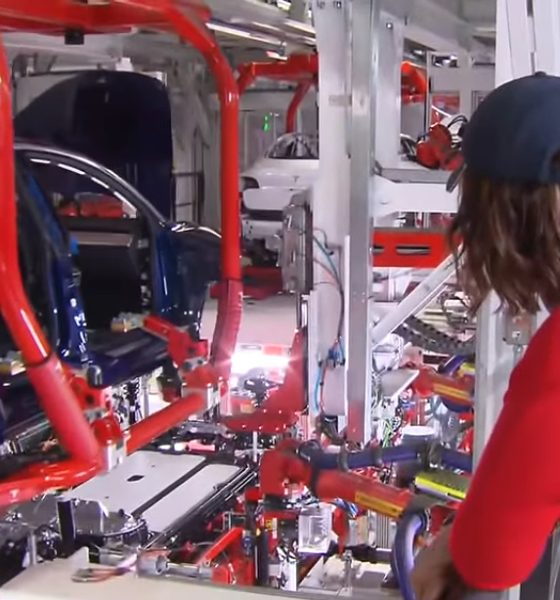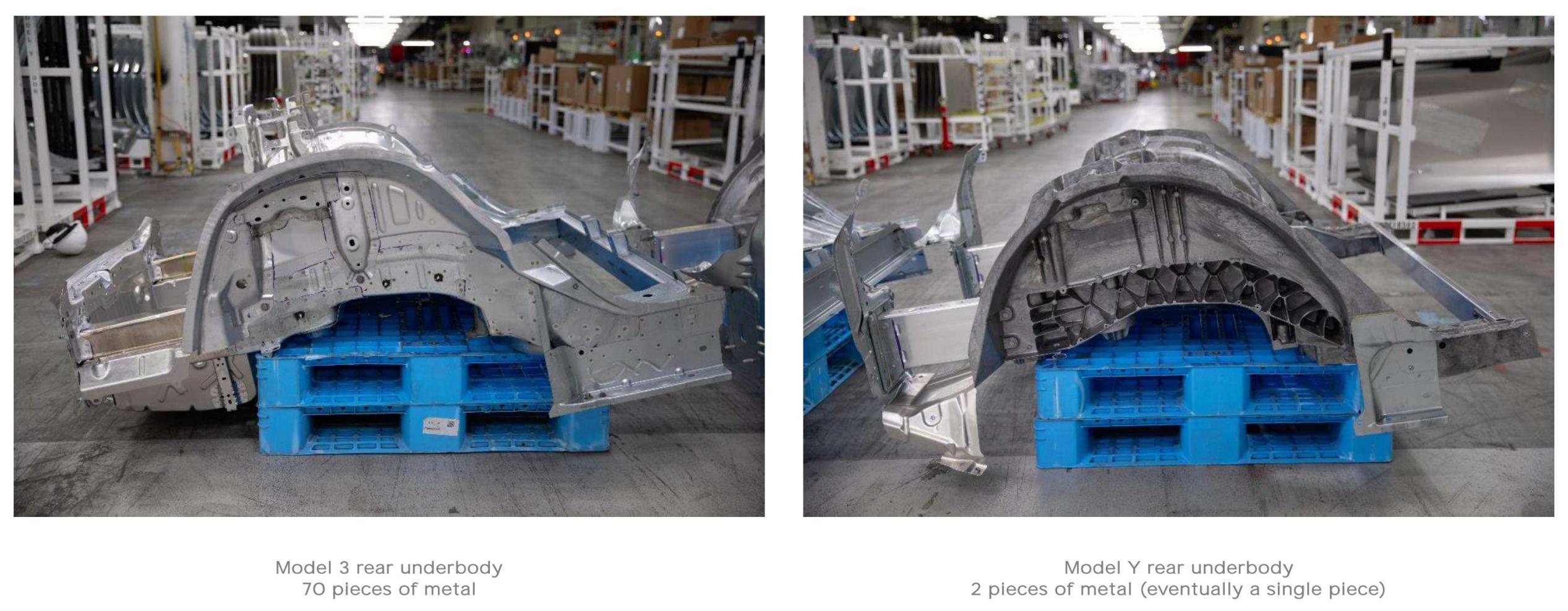

News
Tesla Model 3 single-piece casting will come, but not anytime soon, Elon Musk says
Tesla will “likely” switch the Model 3 sedan to a single-piece casting design in the future, CEO Elon Musk said in an interview with Sandy Munro. However, the design will not be on its way anytime soon, as Musk said the Berlin and Texas Gigafactories need to have production efforts well underway to sustain demand fulfillment.
The Model 3’s current design is not a single piece casting and is comprised of 70 different metal parts welded together to create the vehicle’s underbody. Tesla improved upon this design in its Model Y crossover by using a massive, single-piece casting to eliminate 69 total parts. The single-piece design is effective for manufacturing purposes and increases structural rigidity in the event of an accident.
As the Model Y and Model 3 dominate Tesla’s current sales and delivery figures, Munro mentioned to Musk that he was disappointed that his new Model 3 teardown did not reveal a single piece casting similar to the Model Y design. However, Musk indicated Tesla’s mass-market sedan would eventually use the single-piece casting, it would just take its next two production facilities to be in operation for it to happen.
Musk told Munro:
“At some point, we probably will switch to a single-piece casting, but I think we need to get the Texas factory and the Berlin factory going. We do have an issue. It is hard to change the wheels on the bus when it is going 80 MPH down the highway. So, Model 3 is…well, was most of our volume. Model Y will exceed Model 3, but we just need an opportunity to redo the factory without blowing the cash flow of the company.”
In its Q1 2020 Update Letter, Tesla showed the two designs. The Model Y casting (right) was two pieces at this point in time. Thanks to the introduction of Tesla’s Giga Press from IDRA, the automaker has eliminated the two-piece design in favor of a massive one-piece casting. The elimination of so many parts was a huge advantage for Munro, who detailed the casting advantages in several teardown episodes last year.

Tesla Model Y owner Tony Pham then showed the one-piece casting design on his vehicle while having a third-party accessory installed into his all-electric crossover. Pham’s Model Y was delivered in late 2020, proving that Tesla has been utilizing the one-piece design for several months.
Model Y single piece rear casting!
VIN 97k, delivered 12/23/2020. Thanks @TeslaFrunk for the rear kick sensor installation pic.twitter.com/jkIGwX265v— Tony Pham – “Quick Bandit” license plate mount (@TonyTesla4Life) January 10, 2021
Tesla’s single-piece design is widely thought by automotive engineers, including Munro, to be the most advantageous way to build a car. In Munro’s opinion, other automakers have ignored a single-piece design’s advantages due to their stubbornness to keep things the same. “Thousands of engineers, big-time executives, walk by [the idea]. They don’t do it,” Munro said.
One of Tesla’s manufacturing process’s main advantages is that it continues to refine its techniques and never admits that its current processes are the best way to handle things. Tesla is always looking to improve the situation of its manufacturing and production lines, always seeking different techniques and new ways to build its vehicles. The issue now is that Tesla’s vehicles are becoming so popular that its limited production lines cannot be halted to update some production techniques, especially to mass-market vehicles that have been produced for several years. Musk’s analogy of the bus going 80 MPH down the highway is extremely accurate, especially as Tesla is coming off of its largest production and delivery year in company history. Halting Model 3 production lines for an update to the vehicle’s casting design would be detrimental at the current time.
While it is likely that Model 3 single-piece castings could happen down the road, it is not something to expect soon. With Musk indicating that Giga Berlin and Giga Texas need to be in operation for this to occur, these facilities will likely need to have Model 3 production numbers high enough to offset the closure of lines at Giga Shanghai and Fremont. With Berlin focusing on Model Y production initially, it is likely that Model 3 lines will not be ramped for at least a year, so the single-piece Model 3 casting may not be seen until at least 2023.
Elon Musk’s full interview with Sandy Munro is available below.

News
Tesla FSD fleet is nearing 7 billion total miles, including 2.5 billion city miles
As can be seen on Tesla’s official FSD webpage, vehicles equipped with the system have now navigated over 6.99 billion miles.

Tesla’s Full Self-Driving (Supervised) fleet is closing in on almost 7 billion total miles driven, as per data posted by the company on its official FSD webpage.
These figures hint at the massive scale of data fueling Tesla’s rapid FSD improvements, which have been quite notable as of late.
FSD mileage milestones
As can be seen on Tesla’s official FSD webpage, vehicles equipped with the system have now navigated over 6.99 billion miles. Tesla owner and avid FSD tester Whole Mars Catalog also shared a screenshot indicating that from the nearly 7 billion miles traveled by the FSD fleet, more than 2.5 billion miles were driven inside cities.
City miles are particularly valuable for complex urban scenarios like unprotected turns, pedestrian interactions, and traffic lights. This is also the difference-maker for FSD, as only complex solutions, such as Waymo’s self-driving taxis, operate similarly on inner-city streets. And even then, incidents such as the San Francisco blackouts have proven challenging for sensor-rich vehicles like Waymos.
Tesla’s data edge
Tesla has a number of advantages in the autonomous vehicle sector, one of which is the size of its fleet and the number of vehicles training FSD on real-world roads. Tesla’s nearly 7 billion FSD miles then allow the company to roll out updates that make its vehicles behave like they are being driven by experienced drivers, even if they are operating on their own.
So notable are Tesla’s improvements to FSD that NVIDIA Director of Robotics Jim Fan, after experiencing FSD v14, noted that the system is the first AI that passes what he described as a “Physical Turing Test.”
“Despite knowing exactly how robot learning works, I still find it magical watching the steering wheel turn by itself. First it feels surreal, next it becomes routine. Then, like the smartphone, taking it away actively hurts. This is how humanity gets rewired and glued to god-like technologies,” Fan wrote in a post on X.
News
Tesla starts showing how FSD will change lives in Europe
Local officials tested the system on narrow country roads and were impressed by FSD’s smooth, human-like driving, with some calling the service a game-changer for everyday life in areas that are far from urban centers.

Tesla has launched Europe’s first public shuttle service using Full Self-Driving (Supervised) in the rural Eifelkreis Bitburg-Prüm region of Germany, demonstrating how the technology can restore independence and mobility for people who struggle with limited transport options.
Local officials tested the system on narrow country roads and were impressed by FSD’s smooth, human-like driving, with some calling the service a game-changer for everyday life in areas that are far from urban centers.
Officials see real impact on rural residents
Arzfeld Mayor Johannes Kuhl and District Administrator Andreas Kruppert personally tested the Tesla shuttle service. This allowed them to see just how well FSD navigated winding lanes and rural roads confidently. Kruppert said, “Autonomous driving sounds like science fiction to many, but we simply see here that it works totally well in rural regions too.” Kuhl, for his part, also noted that FSD “feels like a very experienced driver.”
The pilot complements the area’s “Citizen Bus” program, which provides on-demand rides for elderly residents who can no longer drive themselves. Tesla Europe shared a video of a demonstration of the service, highlighting how FSD gives people their freedom back, even in places where public transport is not as prevalent.
What the Ministry for Economic Affairs and Transport says
Rhineland-Palatinate’s Minister Daniela Schmitt supported the project, praising the collaboration that made this “first of its kind in Europe” possible. As per the ministry, the rural rollout for the service shows FSD’s potential beyond major cities, and it delivers tangible benefits like grocery runs, doctor visits, and social connections for isolated residents.
“Reliable and flexible mobility is especially vital in rural areas. With the launch of a shuttle service using self-driving vehicles (FSD supervised) by Tesla in the Eifelkreis Bitburg-Prüm, an innovative pilot project is now getting underway that complements local community bus services. It is the first project of its kind in Europe.
“The result is a real gain for rural mobility: greater accessibility, more flexibility and tangible benefits for everyday life. A strong signal for innovation, cooperation and future-oriented mobility beyond urban centers,” the ministry wrote in a LinkedIn post.
News
Tesla China quietly posts Robotaxi-related job listing
Tesla China is currently seeking a Low Voltage Electrical Engineer to work on circuit board design for the company’s autonomous vehicles.

Tesla has posted a new job listing in Shanghai explicitly tied to its Robotaxi program, fueling speculation that the company is preparing to launch its dedicated autonomous ride-hailing service in China.
As noted in the listing, Tesla China is currently seeking a Low Voltage Electrical Engineer to work on circuit board design for the company’s autonomous vehicles.
Robotaxi-specific role
The listing, which was shared on social media platform X by industry watcher @tslaming, suggested that Tesla China is looking to fill the role urgently. The job listing itself specifically mentions that the person hired for the role will be working on the Low Voltage Hardware team, which would design the circuit boards that would serve as the nervous system of the Robotaxi.
Key tasks for the role, as indicated in the job listing, include collaboration with PCB layout, firmware, mechanical, program management, and validation teams, among other responsibilities. The role is based in Shanghai.
China Robotaxi launch
China represents a massive potential market for robotaxis, with its dense urban centers and supportive policies in select cities. Tesla has limited permission to roll out FSD in the country, though despite this, its vehicles have been hailed as among the best in the market when it comes to autonomous features. So far, at least, it appears that China supports Tesla’s FSD and Robotaxi rollout.
This was hinted at in November, when Tesla brought the Cybercab to the 8th China International Import Expo (CIIE) in Shanghai, marking the first time that the autonomous two-seater was brought to the Asia-Pacific region. The vehicle, despite not having a release date in China, received a significant amount of interest among the event’s attendees.








